
Best Practices for Manufacturing in 2023
Optimising your manufacturing business has never been more important. In this article, we take a look at a few ways to get your processes running at full potential in 2023.
Looking ahead to the challenges for 2023, we identified a set of best practices that will help your manufacturing business run smoothly. While some strategies like improving inventory management will always be on a list like this, we’re taking a look at a few other measures that have become increasingly important.
From implementing new technologies into your workflow, working with your employees to convey your mission and values, and even becoming more mindful of the environment in a changing global landscape - these practices will provide both short and long-term improvements for your venture.
Here’s our list of best practices for manufacturing businesses:
Managing Inventory
Identifying any latencies in your processes is key in maintaining a streamlined operation, and inventory management plays a big role in achieving that goal. By accounting for your inventory at all levels, you can ensure that your production schedules are met, productivity goals are reached, and your equipment is operating with little to no downtime.
A quick and effective measure you can take is using a software solution that brings to light some of the often-overlooked processes like MRO inventory and associated costs.
Software Integrations
The right software solution is catered to the specifics of your manufacturing business and provides enough flexibility to fit in with your processes. Switching inventory management, accounting, CRM, or sales solutions can be costly, but the right switch will provide enough of a boost to your manufacturing business to be worthwhile. Make sure you come up with a comprehensive vetting process when making decisions and you’ll be rewarded.
Remember, integration is key. Pay close attention to how new software gels with existing systems and weigh up how valuable it is to potentially tie your information together.
Optimising Costs
In the current economic landscape, fresh off a supply-chain imbalance, making sure your finances are in tip-top shape feels essential. To that effect, staying on top of costs and ensuring production efficiency, as well as a strong output, are good places to start.
Optimised costs mean more profit can then be invested in new technologies, further increasing productivity. Materials cost is largely dependent on what you make and sell, but smart training policies could improve labour costs, while overhead could be cut through proper inventory management, improved shipping strategies, and lower downtime.
Workforce Management
As workforce deficits continue across markets, a strong policy is to ensure better employee retention through continued training programs. Improving the level of your workforce will provide confidence, better foundational skills, and increase loyalty to the company. As a result, your manufacturing business will likely face reduced turnover, which is paramount in the quest for continued productivity and lower onboarding costs.
Additionally, more frequent interaction with your teams using centralised systems will lead to more employees buying into your values and goals, which increases ownership and personal investment into production goals.
Go Green
With an increasing number of policies in place either favouring or downright calling for more environmentally friendly manufacturing practices across the world, taking measures to make your business more mindful is a form of future-proofing. Making sure that your manufacturing business can take advantage of tax incentives or other government benefits is also a good way to work on cost-cutting.
Sourcing materials from sustainable, or even closer-by sources, is a quick way of working toward that goal, due to its potential to lower the risk of sudden price increases in case of shortages. Taking measures to move to green energy sources is also a great way to move quickly to a greener future.
Cut Waste
Another good thing to cut, besides costs, is waste. This is another long-term move that can provide enduring benefits, and is more easily achievable by implementing some of the measures we mentioned elsewhere on this list. Software solutions that cater to your specific business, more active inventory management, and moving closer to green practices are all pieces of the waste-cutting puzzle, which in turn boosts productivity and lowers overhead.
Reduced waste also means lessening the need to manage the logistics required by managing waste output and could provide added output from your equipment and better use of your resources.
